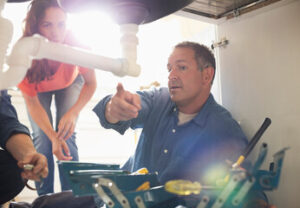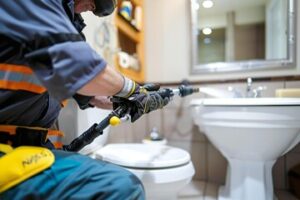Rosenberg Plumbing involves the pipes, fixtures, and other apparatus that distribute clean water and remove waste from a building. Plumbers install, repair, and maintain these systems to ensure safe and efficient operation.

A well-functioning plumbing system supports healthy living by providing a continuous supply of clean, fresh water while minimizing energy and water waste. Proper maintenance can also extend the life of your plumbing appliances and fixtures.
Plumbing is the system of pipes, fixtures, and appliances that bring water into buildings and remove waste. It ensures that clean water is available for drinking, cooking, cleaning, and washing, and that wastewater is effectively removed to maintain a hygienic environment.
Residential plumbing systems are designed to serve the water needs of families and individuals living in private dwellings. Although each home plumbing system varies from the next, all share certain core concepts. Understanding these fundamentals can help you understand and communicate with plumbers when discussing issues like leaks or clogs.
There are two main components of a household plumbing system: the supply system that delivers fresh water and the drainage system that removes wastewater. The supply system includes a water meter that connects to the city water line (or, for those in rural areas, the private well pipe) and a shut-off valve. It also includes a water pressure regulator to control water pressure, which can damage pipes and fixtures if it is too high.
The drainage system consists of drain pipes that carry wastewater to the sewer or septic tank and vent pipes that release sewer gasses. The venting system also helps reduce the risk of a backflow, which can carry contaminants into the freshwater supply. The system also includes traps and valves to keep water from seeping back into the drain pipes when fixtures are not in use.
The plumbing industry is regulated at both the federal and state level to ensure safety, efficiency, and environmental protection. Federal agencies such as the Environmental Protection Agency set standards for water quality and waste management, while each state—including Oklahoma—has its own licensing and inspection requirements. The state standards are often based on national model codes, such as the International Plumbing Code (IPC) or the Uniform Plumbing Code (UPC).
Materials
Pipes are made from a variety of materials, each with its own set of benefits and drawbacks. Understanding the different types of pipes available and their characteristics helps you make informed plumbing decisions that will ensure efficient operation, safety, and longevity.
Metal pipes, such as copper and brass, are known for their durability and resistance to mineral buildup and corrosion. They also withstand high temperatures for extended periods, making them a great choice for hot water lines. However, these pipes are often more expensive than other options and can rust in certain conditions.
More recent materials like PVC, CPVC, and PEX have gained popularity due to their flexibility and cost-effectiveness. These pipes are suitable for a wide range of applications, from cold water to drain lines. They can bend around corners without the need for fittings, which reduces the number of joints and potential leak points. They are also resistant to chemicals and can be installed quickly using crimping or clamping tools.
Choosing the right plumbing materials is essential to prevent costly repairs and keep your family safe from harmful contaminants in your drinking water. Choose pipes that are certified for potable use, and select low-flow faucets and water-saving toilets to help conserve water and lower your utility bills. Sustainable plumbing materials, such as copper, CPVC, and PEX, are eco-friendly and require less energy to produce than traditional metals. They are also recyclable, which reduces waste and environmental impact. If you’re concerned about reducing your carbon footprint, look for lead-free plumbing materials that are free of toxic substances.
Functions
The plumbing industry involves the installation, repair, and maintenance of pipes, fixtures, and appliances that bring water into buildings and remove waste. It is an essential service, ensuring that clean water is available for drinking and cooking and that waste is effectively removed to maintain a hygienic environment. Plumbers are skilled professionals who use a wide range of tools and techniques to perform these tasks. They also interpret blueprints and building codes to plan and execute plumbing installations. They often work with architects and construction teams to ensure that the plumbing systems are integrated seamlessly into building projects and meet all necessary regulations.
Plumbing systems include a complex network of pipes that transport water to and from sinks, faucets, toilets, bathtubs, showers, and other appliances. These pipes are made from durable materials that can withstand high pressure and temperatures. They are sealed with joints and fittings to prevent leakage, and they are connected by valves that control water flow and regulate pressure. Valves also help to isolate sections of the system for repairs and maintenance without shutting off the entire plumbing network.
Marketing KPIs
Effective marketing strategies can help your plumbing business grow and improve customer acquisition and overall profitability. Monitoring these marketing KPIs can help you make data-driven decisions that optimize your plumbing business’s advertising spend and improve lead generation.
Dispatch KPIs
Regularly monitoring these dispatch Key Performance Indicators can help you manage your plumbing business’s resources efficiently and effectively, leading to improved customer service and increased profit margins. These indicators measure important aspects of your dispatch operations, including average invoice value and monthly sales. These metrics are critical for analyzing your plumbing business’s performance and identifying opportunities for improvement.
Installation
The plumbing industry encompasses the pipes, fixtures, and appliances that deliver water and remove wastewater in residential and commercial buildings. Plumbers install, repair, and maintain these systems to ensure they function properly and safely. They use specialized tools and equipment to work in tight spaces. Plumbers also test and inspect plumbing systems to ensure they meet safety and quality standards before they are used in a building.
The installation process of a plumbing system is typically divided into three stages: underground rough-in, aboveground rough-in, and finishing or trim-out. The first stage involves setting the sewer accommodation stubs, which connect the home’s plumbing to the municipal sewerage system. This step happens before the concrete foundation is poured. The next phase involves laying out and installing the main plumbing lines. This includes installing the hot and cold water supply lines, as well as drains and vents. The final stage involves testing and certifying the plumbing system to ensure it meets all regulatory requirements.
Local regulations influence the installation of plumbing systems by establishing safety, health, and environmental standards that vary from region to region. Plumbers must adhere to these codes to avoid potential legal issues.
As the plumbing industry continues to grow, many entrepreneurs are seeking opportunities for growth. Some are looking to expand their current operations while others are interested in purchasing established plumbing companies. Both approaches require a strong understanding of the industry and a solid strategy for success. Larger plumbing service providers enjoy several advantages over their smaller competitors, including a larger labor force, better access to new technology, and a stronger position in the market. They can also charge a premium over their smaller counterparts, as they are able to offer a more comprehensive set of services and amenities.
Maintenance
Plumbing systems are subject to a lot of wear and tear. Regular maintenance procedures can help them last longer and perform better. Plumbing maintenance can include anything from cleaning drains to checking water pressure. It is also important to address issues as soon as they arise, as neglecting minor problems can lead to major damage. For example, a small leak in a pipe may seem harmless, but it can cause water damage and mold growth.
Regular maintenance can also prevent clogs and sewer backups. These are often caused by items that are flushed down the toilet that are too large or shouldn’t be in the pipes, such as sanitary products, cotton swabs, paper towels and other waste. To avoid these problems, make sure to only flush toilet paper and other approved materials. Regular maintenance can also include removing debris from the drain line and ensuring the water shut-off valve is working properly.
A well-maintained plumbing system can also reduce operating costs. For example, leaks can increase water consumption and result in higher utility bills. Regular maintenance can also minimize bacterial buildup in showers and bathtubs, which can reduce the need for water treatment.
In addition to repairing and maintaining plumbing systems, plumbers can also install new fixtures and appliances. They can also collaborate with other professionals, such as architects and construction teams, to ensure plumbing is integrated seamlessly into building projects. Finally, plumbers can help improve sustainability in buildings by promoting conservation and energy efficiency measures. Plumbers must also adhere to a variety of industry codes and regulations, including the International Plumbing Code (IPC), which sets standards for plumbing practices and safety requirements. In addition, plumbers must be familiar with environmental regulations that govern public water supplies.
